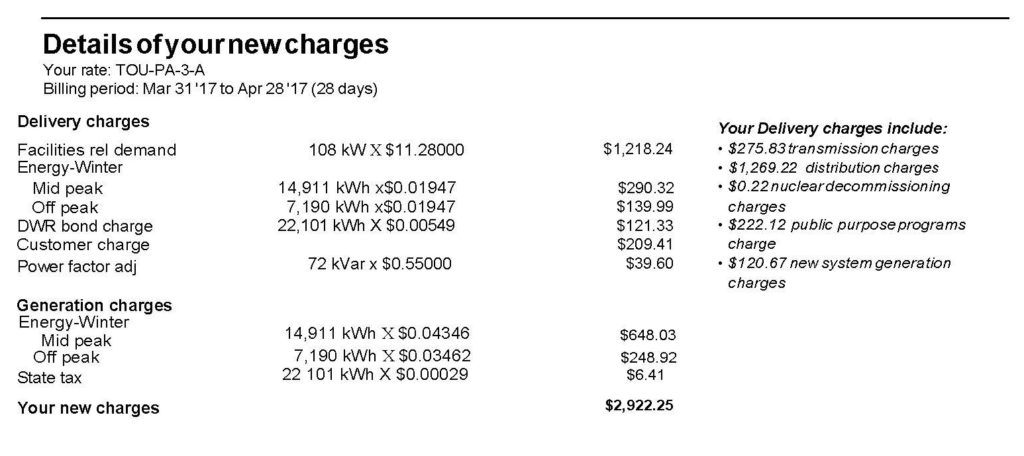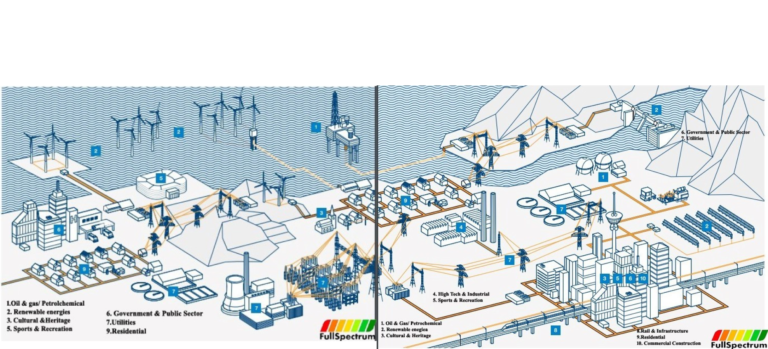With the rising energy costs affecting everybody, most organizations and consumers are complaining that the bills are high, fixed arbitrarily and accuse utilities of sharp practices.
The need for tracking, monitoring and proper energy management has now become prime.
Today we will discuss how bills are structured, the different charges and schedule rates.
Different Charges

Typically, the first thing is to understand electric bills and how they are charged, they may include some or all of the following:
- Customer charge
- Energy (kWh) charge
- Fuel adjustment
- Demand (kW) charge
- Power factor penalty charge
- Taxes and franchise fees
- Late fee
Customer Charge
This charge cover costs associated with meter reading, meter usage, billing and other utility support functions. It varies with the rate class of the customer.
Energy (kWh) charge
Energy charge is the actual energy usage measured in kWh. The energy usage typically will be structured as follows:
Flat Rate – The cost per kWh is constant
Declining Block – The kWh is broken down into blocks and the cost declines for each succeeding block. In other words, the more you consume, the cheaper it gets.
Fuel Adjustment
This charge is a flat rate added on to the kWh charge. It reflects the variations in the price of fuel used to generate the electricity compared to a base price.
Also, the fuel adjustment can be a negative number, although this seldom occurs.
Demand (kW) charge
This charge is for the kW (also called demand) used each month. It typically applies to commercial and industrial customers, depending on the utility rate structure. It is based on the peak demand (as defined by the utility) for each month measured by the meter during a 15 or 30 minute intervals.
The demand charge reflects the capital investment the utility has in the generating, transmission and distribution equipment.

Billing Demand
Many utilities charge their customers not on the actual demand as described above, but on a billing demand.
Depending on the rate structure, this billing demand typically is based on the highest actual demand reached during the summer. This peak summer demand is then used as the demand charge basis for the next eleven months.
Sometimes this is referred to as a ratchet charge. For example, if your peak summer demand was 200 kW in August, then this 200kW or a percentage of it will be used as the demand charge for the next eleven months, when a new billing demand is set.
The determination of ratchet charges varies widely with different utilities, always review the rate structure of the utility involved.
Power Factor Penalty Charge
A low power factor causes the utility to have additional capital investments (generating transmission and distribution equipment) to serve the customer’s load.
A low power factor typically occurs when the facility has a large motor load. Not all utilities have a power factor penalty charge, and if they do, they typically apply to large customers. Low power factor can be corrected by using capacitors on the system or equipment.
Note that if you billed on a demand KVA basis, then a power factor penalty is inherently included.
Taxes and Franchise Fees
These are state and local sales taxes like VAT. Many government agencies are exempt from taxes.

Late Fees
The penalty for not paying on time plus interest charges
Deregulated utilities
If the facility is in deregulated utility, they could receive bills from the electric or gas commodity supplies; the pipes/wire company for transmission and distribution charges and others depending on the terms of deregulation.
Example 1
A commercial customer has set a peak demand of 100kW each month and has used 200,000kWh for the year: Calculate the annual bill using the following:
Customer Charge: $10.000 per month
Demand Charge $8.50 per kW per month
Energy charge: $0.08 per kWh
Fuel Adjustment $0.01 per kWh
Taxes: 5%
Example 2
A hospital has a peak demand of 500kW. During the month of August, the kWh consumption is 250,000kWh. Calculate the August energy bill using the following information from the rate schedule.
Customer Charge $12.00
Demand Charge $10.00 per kW per month
Energy Charges:
First 100 kWh @ 10.5 cents
Next 900 kWh @ 8.7 cents
Next 9,000 kWh @ 7.5 Cents
Next 10,000 kWh @ 6.5 Cents
Next 180,000 kWh @ 5.7 Cents
Over 200,000 kWh @ 5.0 cents
Fuel Adjustment charge for August: 1.2 cents/kWh
Taxes: 6%
Rate classes
Depending on your facility you may fall into one of the following schedules;
- Residential
- Commercial
- Industrial
- Time of Use
- Interruptible
- Real Time Pricing
- Economic Development
Residential
Typically based on the kWh usage only. Some residential rates may include a demand charge if the home is very large. Also, some utilities have a Time of Use (TOU) rate for residences. This TOU rate charges more for kWhs used during the utilities peak usage periods and less for off-peak periods.
Commercial
The commercial rate is typically a demand rate, with the customer being billed for both kWh and kW. Some utilities have non-demand rates for small commercial customers. Also, time of use rates, interruptible rates, real time pricing rates and economic development rates may be offered by the utility.
Industrial
These customers are almost always on some type of demand rate. Also, time of use rates, interruptible rates, real time pricing rates and economic development rates may be offered by the utility.
Time of Use Rate
Most utilities have a Time of Use (TOU) rates that customers can utilize. TOU rates allow the customer to reduce their energy bills by shifting some of their load to off-peak hours. For example, a TOU rate may encourage users to shift some of their operation to after 8:00pm. TOU rates require special meters that track kWh usage and the time of that usage.
Interruptible Rate
This rate allows the customer to contract for lower cost electricity if they can afford to shut down their business or operation with little notice from the utility. Typically, the utility will give the customer at least a 30 minute notice before shutting off the power.
Real Time Pricing
This is a relatively new form of rate structure that prices electricity at what it cost the utility plus a margin each hour of the day. Customers typically get a day’s advance estimate of the hourly cost of electricity in cents per kWh. Customers who are flexible with their operating hours can make the most use of this rate. It is usually less expensive to purchase power in the evenings and other off-peak hours.
Economic Development
This rate is offered by some utilities to attract new business to the areas or to encourage facility expansion. The terms of this rate are typically more attractive than the other rates offered. This type of rate will have a time limit, usually around three to five years.
Master Vs individual Metering
If you have a large facility with many small meters, it may be worthwhile to investigate master metering. The utility would use one meter to read electrical consumption at a centralized service points, thus eliminating many small meters. With this arrangement, you can qualify for a master metering rate, which may save you money. Have your utility representative perform this analysis. Note that distribution work may be required.
FullSpectrum Energy is the foremost Nigerian Energy Service Company, whose prime business is helping organizations SAVE ON energy through proven methods and technologies in Energy Auditing, Conservation, Efficiency, Demand Side Management (DSM), and Renewable Energy.
Contact us NOW


Victor Oyedu, FNSE, FNIEEE, CPQ.
Power Quality and Energy Management Specialist.
Publisher at Afrienergyonline.com
CEO, FullSpectrum Energy Solutions Limited, Nigeria.






